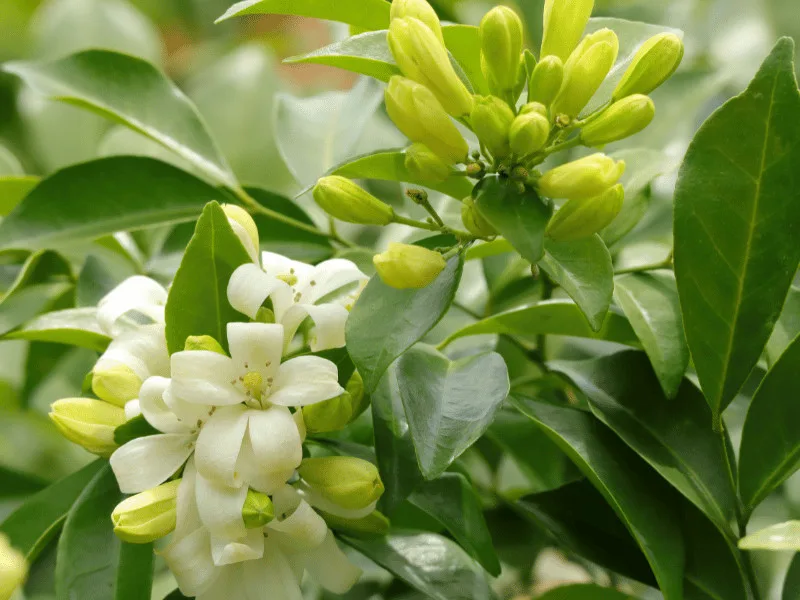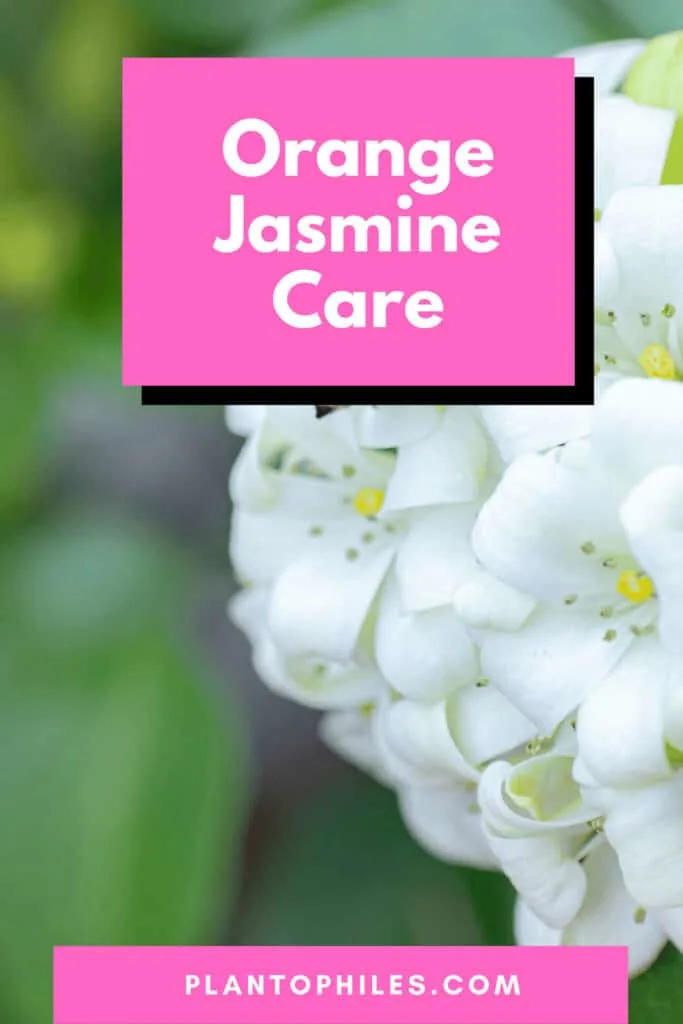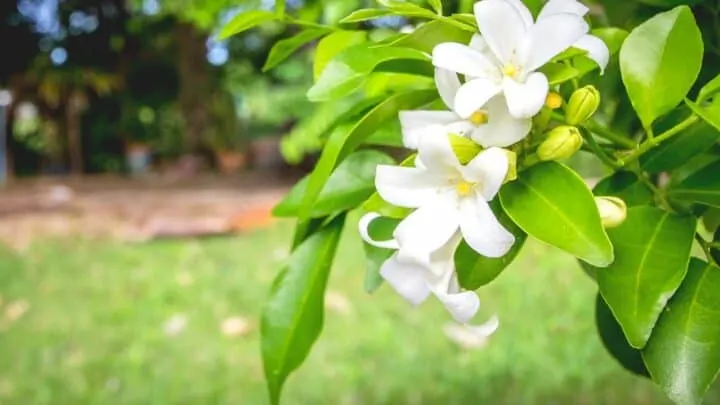You want to learn more about the Orange Jasmine plant or Orange jessamine. This in-depth care guide contains all you need to know.
Orange jasmine Plant
Orange Jasmine, scientifically known as Murraya paniculata, is an evergreen shrub native to Southeast Asia and some parts of Australia. The shrub can be grown as a hedge or in various thicket styles.
It blooms with fragrant white flowers that give off a sweet scent. Mock Oranges plants can grow up to 23 feet tall trees (7-meters), when allowed to grow freely.
Because of their small flowers and bright-colored fruit, they make for excellent Bonsai material.

Takeaways
| pecies | Murraya paniculata |
| Synonyms | Orange jasmine, orange jessamine, china box, mock orange |
| Family | Rutaceae |
| Genus | Murraya |
| Growth | Compact, bushy |
| Height | 10 feet |
| Width | 6 feet |
| Soil | Well-draining |
| Watering | Every 7-14 days |
| Light | Full sun |
| Temperature | 60.0 - 85.0 Fahrenheit (15.6 - 29.4 Celsius) |
| Humidity | 50.0 - 70.0% |
| Fertilizer | Once a week in spring and summer |
| Propagation | Stem cuttings, Air layering |
| Toxicity | Non toxic to humans. Saponins can be toxic to cats and dogs |
Table of Contents
Caring for an Murraya paniculata
To care for Orange Jasmine, use a well-draining mix high in organic matter. It can do well in bright indirect light or direct sunlight in the morning but protects it from harsh sunlight. Water deeply when the top 2 inches of soil get dry. Ideal growing temperatures are between 65-90°F (18-32°C).

Orange jessamine Soil
Murraya Paniculata likes to grow in well-draining organic soil. The soil shouldn’t stay water-logged and should be free of nematodes. You can use regular house plant potting mix for potting your Orange Jasmine. The plant can tolerate slightly acidic soil, from pH levels 6.5-7.5.
When planting a Lakeview Jasmine plant outdoors to grow as a bush or hedge, you must ensure that the area does not get waterlogged very often and does not stay soggy.
You must also not let plant debris or organic matter lay on the soil around the Chinese Box tree. Mulched soils can invite a nematode infestation, drastically impacting plant health.
When growing Murraya paniculata in pots, you can use a regular houseplant potting mix for this plant. If you feel the soil is too heavy, you can use extra ingredients, such as a few parts of sand or organic matter, to improve drainage and aeration.
Light
Orange Jasmine plants like bright indirect light or direct sunlight only for a few hours daily. Protect this plant from harsh midday and afternoon sun. It will thrive if it receives morning sunlight only. The plant can also do well indoors if it gets bright indirect light for 4-6 hours daily.
With dark green foliage, Orange Jasmine plants do not need direct sunlight all day to grow well. On the contrary, they need to be protected from intense sunlight.
Harsh sunlight can cause mild sunburn on its leaves, turning their color from dark, glossy green to a dull, rough texture.
Prolonged exposure to intense sunlight will also waste the precious flowers as soon as they bloom, preventing the plant from producing fruit.
It is best to grow these plants behind walls to protect them from the harsh sun or under the dappled shade of trees. Murraya paniculata can be grown indoors successfully if given a sunny spot next to a window.
Watering
Murraya paniculata is a drought-resistant species and will fare well in dry conditions. However, they need consistently moist soil for best performance and frequent blooms. Water your Orange Jasmine deeply when the top 2 inches of soil dry.
You should always keep your Orange Jasmine plant well-irrigated when grown in the ground to encourage prolonged and frequent blooming.
Although the evergreen bush will tolerate drought-like conditions, it will not bloom when underwatered. Leaves also develop a dull surface with tiny pale-brown spots due to a lack of water.
When grown in pots, give your Orange Jasmine plant a hearty drink every time the top few inches of the soil get dry.
Water deeply so that all parts of the rootball get wet and the water flows out from the drainage hole. In hot weather, the plant may start wilting when the soil is completely deficient in moisture, leading to physiological damage and stunted growth.
When watering your Murraya paniculata, make sure you are watering it from below the foliage level. You don’t want water to sit on the leaves for too long.
The plant may develop a fungal infection called sooty mold if leaves remain wet for too long.
Temperature
Orange Jasmine hails from tropical and sub-tropical regions and likes temperatures on the warmer side. However, this plant will not bloom well if there is too much heat. Ideal growing temperatures are between 65-90°F (18-32°C). Flowers will dry out during the day if the plant blooms at night.
Maintaining the perfect growing temperatures for an Orange Jasmine plant can be tricky.
While they will stop growing when temperatures fall below 45°F (7°C), they can also not grow well if temperatures are higher than 95°F (35°C).
Moreover, they require the temperature between a very narrow limit to bloom well and convert fruit from flowers. If the plant manages to bloom, but temperatures get too high, the flowers wilt away without bearing fruit.
This plant does not tolerate frost and needs to be overwintered indoors or in a greenhouse for the winter. You can grow this plant outdoors all year if you live in USDA Hardiness Zones 10-12.
Humidity
To thrive, the tropical evergreen plant needs humidity levels above 40-50%. They will only maintain prolonged blooms if the humidity is adequate. However, high humidity coupled with poor ventilation can lead to a range of health problems for this plant.
When you overwinter this plant indoors for the winter, you must maintain high humidity for an Orange Jasmine.
You can employ many methods to replicate tropical conditions, but misting the plant with water should not be one of them.
Misting plants to give them the humidity they need is not a very well-proven method for bringing up humidity levels. On the contrary, it can lead to greater harm if the water sits too long on the foliage.
Using a humidifier or humidity tray is a much better option.
Fertilizer
Fertilizing your Orange Jasmine plants every 3-4 weeks is recommended to encourage dark green and glossy foliage and vibrant blooms. Using organic compost is always better than artificial fertilizer. Still, you can use a water-soluble fertilizer for plants growing indoors or as Bonsai trees.
Fertilizing will help your Orange Jasmine plant stay healthy and maintain attractive foliage.
When growing Murraya paniculata as a Bonsai tree, the small amount of soil available can soon run out of the nutrients needed to sustain healthy growth.
So, with repotting every two years, you will want to feed your Orange Jasmine Bonsai with an adequate dose of balanced fertilizer.
Growth
Murraya paniculata is an evergreen, medium-sized shrub that can grow as tall as 7m when allowed to grow freely. Foliage is dense and glossy, each leaf comprising of up to 7 leaflets. Clusters of five-leafed white flowers bloom in the growing season. Growth is most vigorous when this plant is young.
Orange Jasmine grows with an upright and spreading dense crown. When it blooms, it attracts bees and other pollinators and has a strong sweet-smelling scent.
You will not miss the fragrance of Orange Jasmine blooms when you are within 10 meters of the plant.
Growth is most vigorous during spring and late summer. The dark colors of the leaves and the light-colored bark make an excellent contrast when this bush is grown as a Bonsai tree.
As the bush grows into maturity, the base of the trunk grows into beautiful, seasoned shapes and textures.
Potting
When growing in pots, Orange Jasmine plants need enough soil volume that they retain water over 2-3 days. Small pots are not recommended as the soil moisture evaporates very quickly, leaving the plant with various physiological problems. Clay pots are recommended over other pots.
If you’re growing Orange Jasmine Bonsai, and the soil frequently dries up in the summer months, you might notice a gradual decrease in the plant’s health.
When growing in soil that becomes completely deficient in moisture frequently, Orange Jasmine leaves can fade, and tiny pale spots start appearing on the leaflets.
This converts the general color and texture of the foliage from dark and glossy green to dull and light green. The growth also becomes stunted until the plant recovers in health.
Adequate drainage is an absolute must for growing Orange Jasmine.
Pruning
Orange Jasmine plants react very well to pruning, so they’re so popular as hedges. Pruning is done during the growing season and to the tips of leaves to encourage vigorous, bushy growth. These plants grow suckers from the base of the trunk. They shall be removed as soon as they appear.
When growing as a hedge, a neat bush, or even as Bonsai, Orange Jasmine plants need regular pruning to be kept in shape.
Fresh leaves can stick out of the foliage mass; before you know it, your Orange Jasmine bush is everywhere. These plants need pruning almost every 3-4 weeks in tropical and subtropical regions.
Hard pruning is best down during early spring or the rainy season so that new foliage springs right back without the plant facing the risk of dieback.
However, hard pruning can sometimes result in the plant not blooming the following growing season.
Orange Jasmine Propagation
The easiest way to propagate Orange Jasmine plants is through seeds. It can be grown from cuttings but with lower success. Cuttings should be taken from areas without flower growth and planted in peat, sand, or any suitable rooting medium. Dipping the cutting in the rooting hormone can boost results.
Orange Jasmine plants can easily be air-layered in the right season, providing excellent Bonsai material in a jiffy. A Standard air-layering procedure can be followed to propagate this plant.
Whether growing from seed, cuttings, or air-layering, you must provide a warm and protected environment for the plants to survive the delicate stage.
Place them somewhere warm and shaded and with adequate water. Covering the cuttings or air layering with a plastic bag can help as it mimics a mini greenhouse.
Orange Jasmine flower
Orange Jasmine flowers are small, white, and fragrant. Murraya paniculata blooms throughout the year. The flowers are waxy and showy. The fragrance has a nice orange flower smell.
The numerous sweet-smelling flowers and fruits look great when this shrub is trained as a bonsai.
This shrub is mostly grown for its flowers and not for its fruits.
Orange Jasmine fruit
The Orange Jasmine produces fleshy fruits with 1 inch in length (2.5 cm), according to Simple Decor Ideas. They are non-edible. They are colored red to orange and have an oval shape.
The Orange Jasmine fruits look more like little berries and not like an orange. They resemble Coffee Plant fruits but are oval and not round.
Is Orange Jasmine Poisonous?
Orange Jasmine is not poisonous to humans as well as cats and dogs. But as with most plants, you should not ingest it as it can lead to diarrhea and vomiting.
Common Problems with Orange Jasmine
Nematodes
Some nematodes are beneficial for your plants, but some are not. Nematodes stay under the ground and infect the roots of your Orange Jasmine plant.
Nematodes are usually found under mulched soil and can spread viruses to your plant, making them severely sick.
Fighting nematodes away isn’t easy, but you can prevent a nematode infection by buying your plants from reliable sources and using nematode-free soil.
Sooty Mold
Sooty mold is a black fungus growth that can cover up leaves and block sunlight from reaching the plant. You can efficiently deal with this fungal infection by using neem oil spray a few times weekly.
Some pests can leave honeydew on the foliage, which encourages mold growth. Watering the plant at its base and eliminating insects that produce honeydew will also help prevent a sooty mold infection.
Frequently Asked Questions about Orange Jasmine
Are Orange Jasmine berries edible?
The red-colored Orange Jasmine fruit is not poisonous. But they are also not edible, as there isn’t much to eat. 90% of the fruit body comprises a large seed, and the pulp is tasteless.
When does Orange Jasmine bear fruit?
Orange Jasmine plants can bear fruit after blooming, usually mid-spring or late summer. When not provided with the right conditions, these plants bloom but fail to fruit.
How hard can you prune back Orange Jasmine?
Orange Jasmine plants respond well to pruning. You can hard prune the plant severely, and it will spring back up just fine. But pruning must only be done during spring and summer growing seasons. Hard pruning during the dormant season can lead the stems to die back.
Conclusion
The tiny red fruit hanging from an Orange Jasmine tree replicates the look of a mature fruit tree in nature. Keep it well-watered and keep it protected from harsh sunlight. These are the two most important Orange Jasmine care tips to remember.

Daniel has been a plant enthusiast for over 20 years. He owns hundreds of houseplants and prepares for the chili growing seasons yearly with great anticipation. His favorite plants are plant species in the Araceae family, such as Monstera, Philodendron, and Anthurium. He also loves gardening and is growing hot peppers, tomatoes, and many more vegetables.


